
#Ewallet review 2015 software#
You can also use KeepKey with other software wallets like Electrum and M圜elium. The whole process, including adding PIN protection and writing down your recovery seed takes about 5 minutes.
#Ewallet review 2015 download#
You’ll need to download the KeepKey client from the Chrome web store, connect your device and follow the instructions you see on the screen. Setting up your KeyKey for the first time is pretty similar to any other hardware wallet. For the complete list of Keepkey supported coins click here. The main supported coins are:įor reference, TREZOR and Ledger support over 1000 assets each.

The device uses the same 2nd screen protection that TREZOR and Ledger use which makes it more secure to keystroke spying.įalling a little short of its competitors, KeepKey supports 40 different digital assets. The device itself also feels much more durable than the competition.Įven though you won’t be able to walk around with it in your pocket unnoticeably, like you would with a TREZOR or Ledger, you still need to remember that this is a hardware wallet which is used to store large amounts of Bitcoin – so why would you want to walk around with it in the first place?

It may sound stupid but KeepKey’s sleek design and cool digital animation makes the experience of using it feel much better than other hardware wallets. The content of the box includes the KeepKey hardware wallet, a USB cable to connect the KeepKey wallet to your computer, a card to write your recovery sentence on and a nice leather case to keep that card in. The box comes with a KeepKey seal which shows that no one has opened it before you, indicating that the device is secure. You can tell that a lot of thought was put into the packaging and product design. The first thing you’ll notice when you get your KeepKey is how exciting the whole unboxing process is. The company is headed by Darin as the CEO and Ken Hodler (yes, Hodler is his actual name) as the CTO. KeepKey acquired the Bitcoin wallet Multibit in 2016, and was later acquired itself by Shapeshift on August 2017. KeepKey was founded by Darin Stanchfield in 2015 and is headquartered in the US. Later on came the Ledger Nano S, and finally came Keepkey.Įven though today there are multiple companies that manufacture hardware wallets, these three still remain the top choice for crypto enthusiasts. The first hardware wallet to reach mass Bitcoiner adoption was TREZOR with the TREZOR One. If you want a more detailed review about different types of wallets watch our complete wallet tutorial:ĭue to the way hardware wallets are designed, it’s possible to use them safely even with computers infected with malware. This way a remote attacker won’t be able to steal your coins. Basically, a hardware wallet is a piece of hardware that stores your private keys and is not connected to the Internet. In 2013 a new type of cryptocurrency wallet has emerged – the hardware wallet.

If you want a more detailed review of KeepKey keep on reading, here’s what I’ll cover: Overall KeepKey is a solid hardware wallet. When comparing it to its main competition (the TREZOR One and Ledger Nano X), it still lacks the coin support and company reputation. It is beautifully designed, easy to use and comes at an affordable price. KeepKey is a cryptocurrency hardware wallet that supports over 40 different crypto assets. In this post I’ll review the wallet from head to toe and also share my personal experience with it. KeepKey is one of the top 3 hardware wallets around today (along with TREZOR and Ledger). KeepKey Hardware Wallet Review – A Beginner’s Guide


 0 kommentar(er)
0 kommentar(er)
